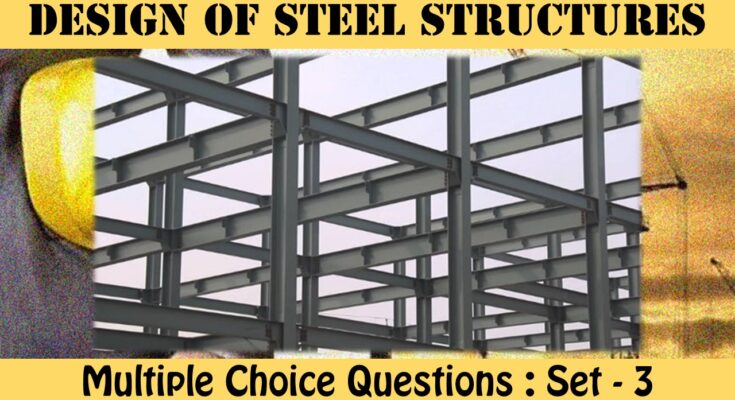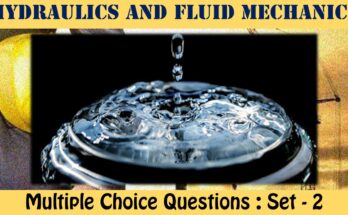MCQ Questions Civil Engineering Design of Steel Structures
The interviewer is almost as nervous as the candidate in most interviews. You might wonder if you look confident enough, if you will hire the right person, or if you are asking the right engineering interview questions. The last question is arguably the most crucial part to worry about when you’re interviewing candidates. Other topics on Civil Engineering Multiple Choice Questions can be accessed
MCQ Questions Civil Engineering Design of Steel Structures - Set - 3
Question 1:
According to IS:800, in the Merchant Rankine formula the value of imperfection index (n) is
a) 1.0
b) 1.4
c) 1.8
d) 2.0
Correct Answer – (B)
Question 2 :
The maximum slenderness ratio of a compression member carrying both dead and superimposed load is
a) 180
b) 200
c) 250
d) 350
Correct Answer – (A)
Question 3 :
According to IS Specifications, the effective length of a column effectively held in position at both ends and restrained in direction at one end is taken as
a) 0.67 L
b) 0.8 L
c) L
d) 1.5 L
Correct Answer – (B)
Question 4 :
A circular column section is generally not used in actual practice because
a) it is uneconomical
b) it cannot carry the load safely
c) it is difficult to connect beams to the round sections
d) all of the above
Correct Answer – (C)
Question 5 :
The actual thickness of butt weld as compared to the thickness of plate is usually
a) more
b) less
c) equal
d) none of the above
Correct Answer – (A)
MCQ Questions Civil Engineering Design of Steel Structures
Question 6:
The maximum slenderness ratio of a steel column, the design of which is governed by wind or seismic forces is
a) 150
b) 180
c) 250
d) 350
Correct Answer – (C)
Question 7:
The effective length of a battened strut effectively held in position at both ends but not restrained in direction is taken as
a) 1.8 L
b) L
c) 1.1 L
d) 1.5 L
Correct Answer – (C)
Question 8:
The slenderness ratio of a column supported throughout its length by a masonry wall is
a) zero
b) 10
c) 100
d) infinity
Correct Answer – (A)
Question 9:
According to IS Specifications, the maximum pitch of rivets in compression is
a) lesser of 200 mm and 12 t
b) lesser of 200 mm and 161
c) lesser of 300 mm and 32 t
d) lesser of 3 00 mm and 24 t
where t is thickness of thinnest outside plate or angle.
Correct Answer – (A)
Question 10:
A butt weld is specified by
a) effective throat thickness
b) plate thickness
c) size of weld
d) penetration thickness
Correct Answer – (A)
- NCERT Solutions Class 12 Mathematics RD Sharma Sets : Exercise 1.1
- NCERT Solutions Class 12 Mathematics RD Sharma Sets : Exercise 1.2
- NCERT Solutions Class 12 Mathematics RD Sharma Sets : Exercise 1.3
- NCERT Solutions Class 12 Mathematics RD Sharma Sets : Exercise 1.4
- NCERT Solutions Class 12 Mathematics RD Sharma Trigonometric Functions : Exercise – 5.1
- NCERT Solutions Class 12 Mathematics RD Sharma Trigonometric Functions : Exercise – 5.2
- NCERT Solutions Class 12 Mathematics RD Sharma Trigonometric Functions : Exercise – 5.3
- NCERT Solutions Class 12 Mathematics RD Sharma Quadratic Equations : Exercise – 14.1
- NCERT Solutions Class 12 Mathematics RD Sharma Quadratic Equations : Exercise – 14.2
- NCERT Solutions Class 12 Mathematics RD Sharma Linear Inequations : Exercise – 15.1
- NCERT Solutions Class 12 Mathematics RD Sharma Linear Inequations : Exercise – 15.2
- NCERT Solutions Class 12 Mathematics RD Sharma Linear Inequations : Exercise – 15.3
- NCERT Solutions Class 12 Mathematics RD Sharma Linear Inequations : Exercise – 15.4
- NCERT Solutions Class 12 Mathematics RD Sharma Linear Inequations : Exercise – 15.5
- NCERT Solutions Class 12 Mathematics RD Sharma Linear Inequations : Exercise – 15.6
Multiple Choice Questions for Competitive Exams
- Multiple Choice Questions Class 12 Chemistry The Solid State
Set -1 Set -2 Set -3 Set -4 Set -5 - MCQ Questions Class 12 Solutions With Answers
Set -1 Set -2 Set -3 Set -4 Set -5 - MCQ Questions Class 12 Electrochemistry With Answers
Set -1 Set -2 Set -3 Set -4 Set -5 - MCQ Questions Class 12 Chemical Kinetics With Answers
Set -1 Set -2 Set -3 Set -4 Set -5 - MCQ Questions Class 12 Surface Chemistry With Answers
Set -1 Set -2 Set -3 Set -4 Set -5 - MCQ Questions Class 12 General Principles and Processes of Isolation of Elements With Answers
Set -1 Set -2 Set -3 Set -4 Set -5




